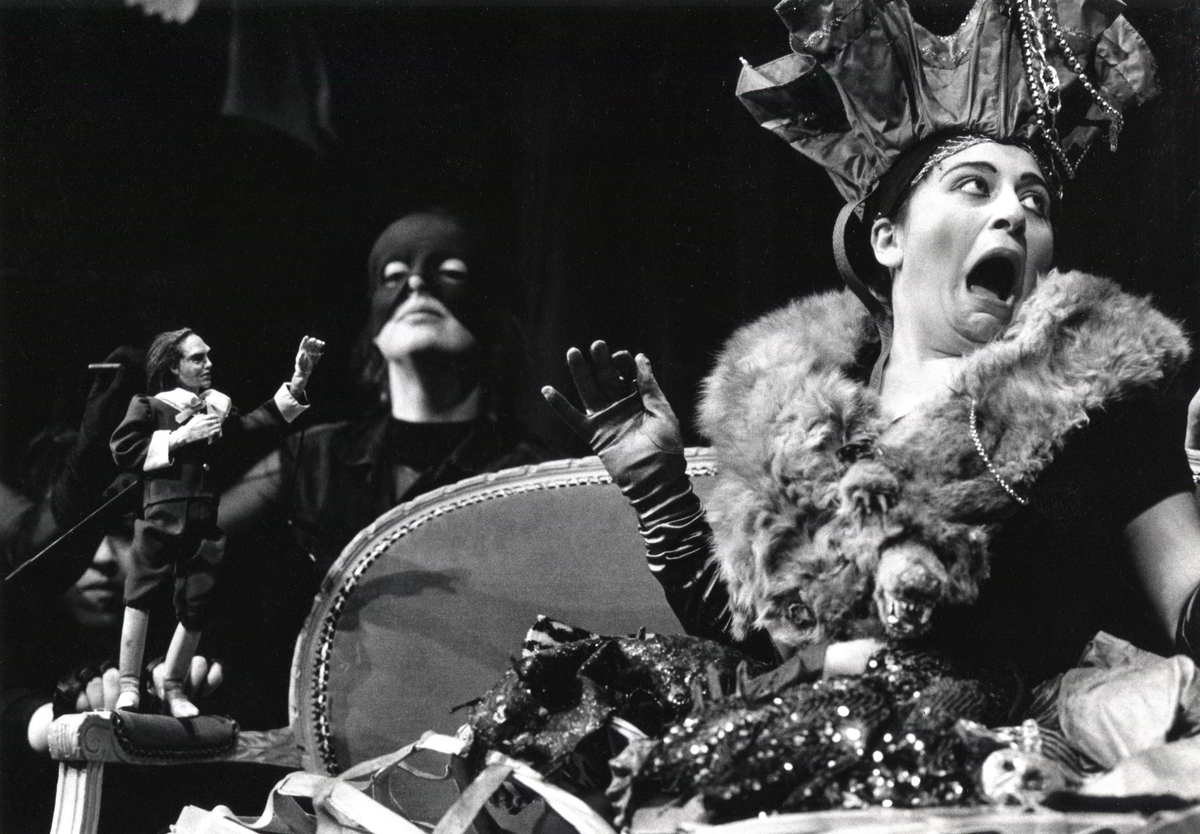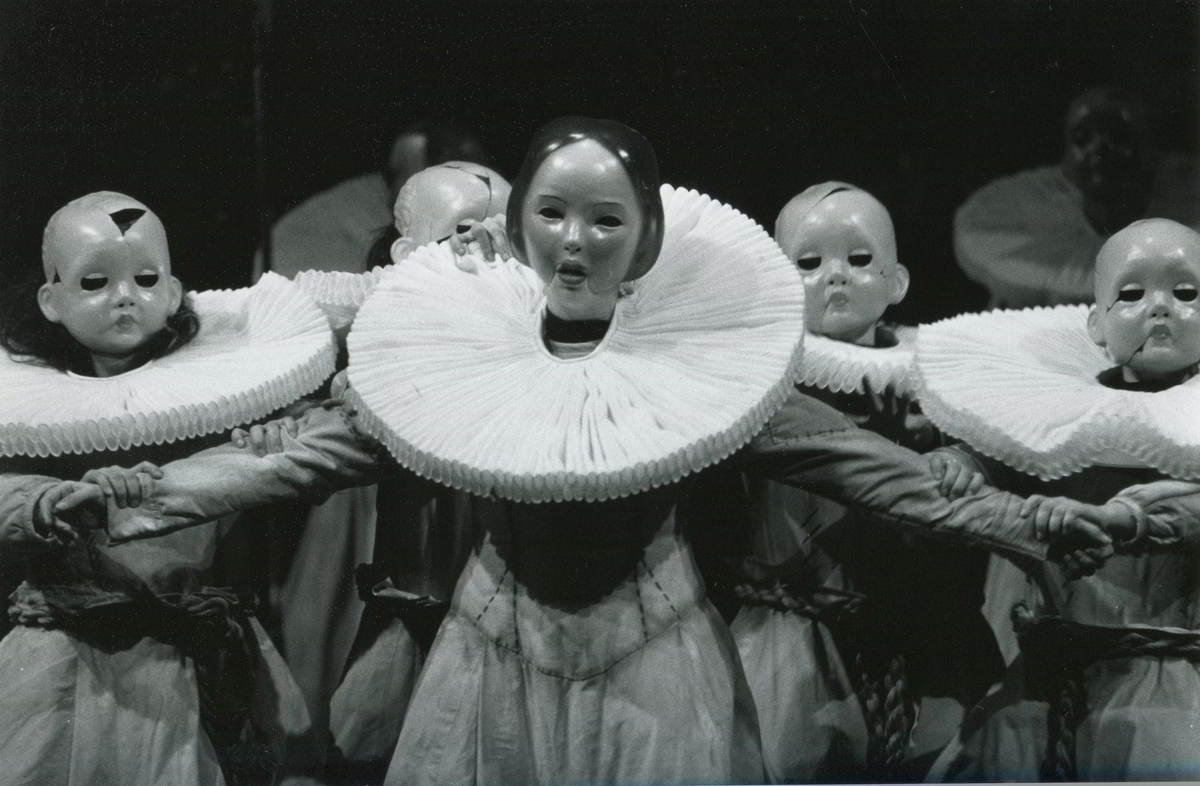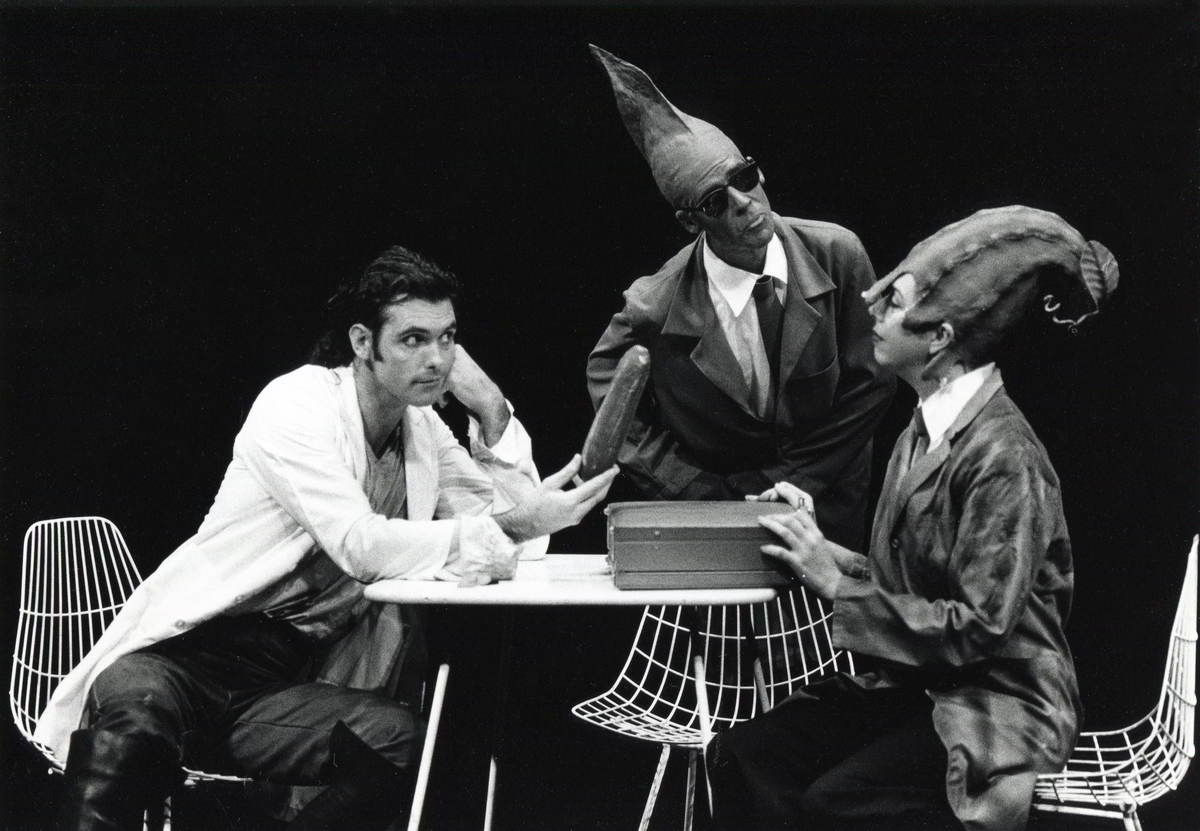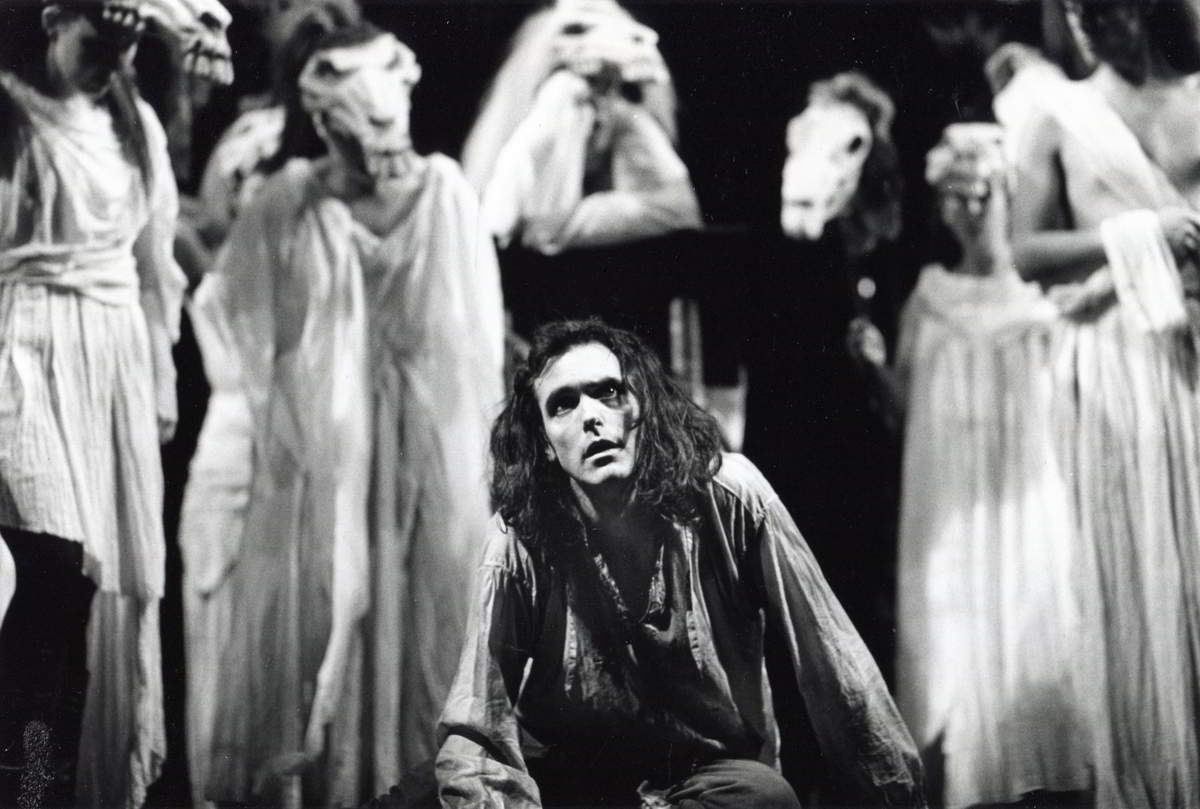| Co-production | HANDSPAN THEATRE and MELBOURNE THEATRE COMPANY (MTC) |
| Premiere | 19 June 1992 |
| Venue | The Playhouse, Victorian Arts Centre, Melbourne |

Gulliver's Travels , Handspan Theatre and Melbourne Theatre Company
Grildig, puppeteer Lizz Talbot with the Brobdingnagian Queen, Nadia Coreno
A Handspan Theatre and Melbourne Theatre Company collaboration was originally planned In 1989 to produce an adaptation of Arthur Conan Doyle’s The Lost World. Although it went no further than early workshop development, the collaboration evolved into a new work, billed as the first complete staging of Gulliver's adventures1
.
By 1992, Handspan had a new Artistic Director, David Baird, replacing Trina Parker & Peter J.Wilson who had established the partnership with Melbourne Theatre Company and Andrew Bovell had been newly-appointed as writer-in-residence at MTC. These personnel changes in both organisations saw the project alter in concept and substance.
Handspan had previously staged GULLIVER'S TRAVELS with students at Kealba High School (1979)2 , and knew the work to be supremely suited to dramatisation with puppets. Swift plays with scale and fanciful image not only to tell his story, but to underline its socio-political commentary. On stage with puppet characters, large and small human replicas and anthropomorphised creatures, and costumed actors, his word pictures resonate in live action.
Bovell was excited by the work:
the underlying themes in the book are still relevant. What divides us now divides us then: politics and religion. Swift saw these problems as eternal and went through his own kind of misanthropic journey. Gulliver realises humanity is a nasty creature and tries to leave it behind, but in the end, he cannot.
GULLIVER'S TRAVELS was an unusual co-production for Handspan. After Trina's departure and in the absence of Ken Evans and Philip Lethlean, Handpan had lost its key, experienced design leaders and with them much of its skill and capacity to co-create the work as a visual production. In the vacuum GULLIVER'S TRAVELS evolved as a play that 'used puppets' as characters in a story, rather than as essentially visual elements making their own drama.
The tall tale staged
Scriptwriter Andrew Bovell’s adaptation followed the narrative of the book. In four acts, Gulliver visited Lilliput, Brobdingnag, the Land of the Houyhnhnms and Laputa. Played by an actor, Andrew McFarlane, Gulliver experienced each world in abridged scenes from the original.
Angas Strathie, theatre designer, came to the production through the MTC. On an open stage, he blended quirkily costumed actors, puppets and their manipulators together to give characters a duality of scale and mobility that illustrated the ideological juxtapositions of Swift’s fantasy narrative.
Lilliputians in Act 1 appeared as celluloid dolls with stiff, limited movement: masked actors and puppets alike. Rows of miniature Lilliputians, seen through a window at court, set the scale of their world. Actor Lilliputians enacted scenes and voiced dialogue, and became puppets when meeting with Gulliver. At moments shadows of Gulliver loomed hugely over the small figures. His presence at the trial began with a large two-dimensional eye blinking at the reading of the Emperor’s rules.
In Act 2, when Gulliver is small and the Brobdingnagians giant-size, Gulliver himself was both puppet and human, known as Grildig to his captors. People from Brobdingnag were extravagantly stylised in absurdist, cartoonseque costumes. Grildig, the actor aped Grildig, the puppet, as he humiliated himself explaining ‘the game called war’ to the King. Found to be pompous and boastful, and shunned by the court Gulliver was snatched from the kingdom in a huge eagle’s talons.
In Acts 3 and 4 Laputians were represented in conical head-dress, and Houyhnhnms, in horse-head masks and flowing drapery. Without the need for scale comparison, the play‘s design allowed narrative text to take over for these scenes. Its imagery in the last acts was mostly in the absurdist costuming of actors and puppeteers.
There is no record of whether or not additional image elements were planned for the second half of the play perhaps they were unnecessary, or perhaps they were discarded as a difficult rehearsal process progressed. Their absence was noted and rued by Merilyn Minell who saw the play and its rehearsal many times and discussed it in her thesis, concluding: 'I believe there are scenes in these latter parts that could have made better use of puppets than they did'.3
Whatever the case, GULLIVER'S TRAVELS could not have been an easy play to stage. Handspan had rarely used their theatre of imagery as an illustrative component of a narrative drama. David Baird was ambitious for the medium but apparently fairly ignorant of its practice. Most company artists were tiptoeing in an unfamiliar milieu in the well-resourced and regulated environment of the State Theatre company. And, there were so many puppets and objects to operate!
Terry O’Connell, directed the production and although he was experienced across many performances genres, that didn’t include puppetry. The interweaving of design elements and transitions of character across form and scale, made directorial focus crucial, but complex and technically time-consuming to achieve. While the design was beautiful and effective, they were realised by, rather than evolved from the Handspan production ensemble. Their possibilities and limitations were revealed in rehearsal rather than in creative development.
Seven actors and six puppeteers, in unfamiliar territory, no doubt struggled to find common ground within the process and build a cohesive performance ensemble.
Expectations were high, but the collaboration was not a success. By production week, the play was foundering. David Baird, out of his depth as Puppetry Director, resigned from the project. Long term Handspan members continued in the play and it went on to play its advertised Melbourne and Geelong seasons.
The show's complexity and the difficulty of its process was apparent to critic, Fiona Scott-Norman in The Bulletin:
If theatrical productions were rated with degrees of difficulty, as are Olympic dives, the production of 'Gulliver's Travels' ...would rate at least as nine. A hybrid between the Melbourne Theatre Company and Handspan, 'Gulliver's Travels' has to be one of the most ambitious projects attempted by either...the success and failure of this play may be attributed almost entirely to a single source; the production is so bursting with competing creative inputs that it is ultimately unmanageable ...such an extraordinary piece of genetic engineering that it cannot be boring, but cannot function properly either.
| Creative team | |
|---|---|
| Adapted by | Andrew Bovell |
| Director | Terry O’Connell |
| Designer | Angus Strathie |
| Puppetry director | David Baird |
| Puppetry designer | Philip Millar |
| Lighting designer | Jamieson Lewis |
| Composer | Tassos Ioannides |
| Movement | Andrea Furness |
| Assistant to the director | Yaron Lifschitz |
| Puppet Makers | Richard Mueck, Cliff Dolliver, Mary Sutherland, Rod Primrose, Ingrid Maganov, Rob Matson |
| Performers | |
|---|---|
| Captain Lemuel Gulliver | Andrew McFarlane |
| Musician | Boris Conley |
| ACT 1 - Lilliput | |
| Actors: | |
| Skyresh | Jennifer Castles |
| Flimnap | Nadia Coreno |
| The Empress/Treasurer’s Wife | Merridy Eastman |
| The General | Jacek Koman |
| Reldresal | Mark Neil |
| The Emperor | Hugh Wayland |
| Puppeteers: | |
| Reldresal | Andrew Hansen |
| The Empress | Avril McQueen |
| Flimnap/Reldresal | Heather Monk |
| Skyresh/Tailor | Lizz Talbot |
| The Emperor | Peter J.Wilson |
| The Empress/Tailor | Annie Wylie |
| ACT 2 - Brobdingnag | |
| Actors: | |
| Glumdalclitch | Jennifer Castles |
| Farmer’s Wife/Queen | Nadia Coreno |
| Slardral | Merridy Eastman |
| Farmer/King | Jacek Koman |
| Grultrud/Maid of Honour | Mark Neil |
| Maid of Honour | Hugh Wayland |
| Puppeteers: | |
| Rat/Monkey FX/Eagle | Andrew Hansen |
| Rat/Monkey FX/Eagle | Avril McQueen |
| Grildig/Monkey/Eagle | Heather Monk |
| Grildig/Monkey FX/Eagle | Lizz Talbot |
| Grildig/Monkey/Eagle | Peter J.Wilson |
| Rat/Monkey/Eagle | Annie Wylie |
| ACT 3 - Laputa | |
| The Queen/Projector | Jennifer Castles |
| Flapper/Projector | Nadia Coreno |
| Flapper/Projector/Mad Woman | Merridy Eastman |
| Pirate/Projector/Struldbrug | Jacek Koman |
| The King/Pirate/Ghostly waiter | Mark Neil |
| Japanese Pirate/Munodi | Hugh Wayland |
| Projectors’ Experiments | Andrew Hansen, Avril McQueen, Heather Monk, Lizz Talbot, Peter J.Wilson, Annie Wylie |
| ACT 4 - Houyhnhnms | |
| Foal | Jennifer Castles |
| Sorrel Nag | Nadia Coreno |
| Mistress | Merridy Eastman |
| Master | Jacek Koman |
| Colt | Mark Neil |
| Old Houyhnhnm | Hugh Wayland |
| Ghost Horses | Andrew Hansen, Avril McQueen, Annie Wylie |
| Production team | |
|---|---|
| Production co-ordinator | Peter Roehlen |
| Puppetry production manager | Paul Judd |
| Stage manager | Greg Diamantis |
| Assistant stage managers | Maria Roberts & Mary Benn |
| Sound recording | Kerry Saxby |
| Photographer | Jeff Busby |
| Seasons | |
|---|---|
| 19 June – 18 July | The Playhouse, Victorian Arts Centre |
| 23 – 25 July | Ford Theatre, Geelong Performing Arts Centre, Victoria |
| Total performances | 36 |
| Total audience | 19,121 |






